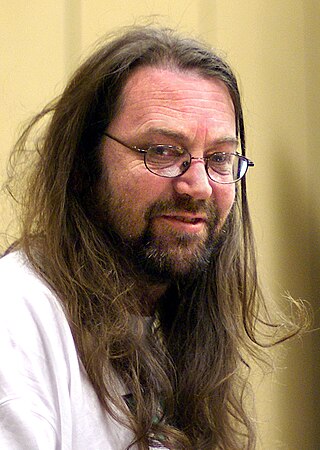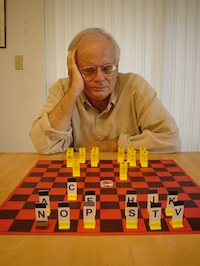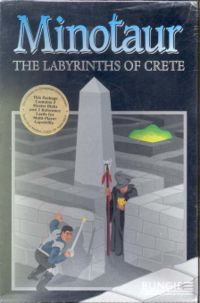| Theseus and the Minotaur | |
|---|---|
 Cover art by Larry Elmore | |
| Developer(s) | TSR |
| Publisher(s) | TSR |
| Platform(s) | Apple II |
| Release | 1982 |
| Mode(s) | Single-player |
Theseus and the Minotaur is a 1982 video game published by TSR for the Apple II.
| Theseus and the Minotaur | |
|---|---|
 Cover art by Larry Elmore | |
| Developer(s) | TSR |
| Publisher(s) | TSR |
| Platform(s) | Apple II |
| Release | 1982 |
| Mode(s) | Single-player |
Theseus and the Minotaur is a 1982 video game published by TSR for the Apple II.
Theseus and the Minotaur is game in which the player must search for princess Ariadne in a maze and bring her out. [1]
Chris Smith reviewed Theseus and the Minotaur in The Space Gamer No. 57. [1] Smith commented that "Overall, this is a good game. The maze is different every time, though I can find no real difference between a complexity 1 and a complexity 100 game (they give you a choice at the beginning of each game). If the mental challenge of finding the secret doors and mapping out the labyrinth despite the halls of mirrors appeals to you, then I recommend this game." [1]

In Greek mythology, the Labyrinth was an elaborate, confusing structure designed and built by the legendary artificer Daedalus for King Minos of Crete at the Knossos. Its function was to hold the Minotaur, the monster eventually killed by the hero Theseus. Daedalus had so cunningly made the Labyrinth that he could barely escape it after he built it.

In Greek mythology, the Minotaur is a mythical creature portrayed during classical antiquity with the head and tail of a bull and the body of a man or, as described by Roman poet Ovid, a being "part man and part bull". He dwelt at the center of the Labyrinth, which was an elaborate maze-like construction designed by the architect Daedalus and his son Icarus, upon command of King Minos of Crete. The Minotaur was eventually killed by the Athenian hero Theseus.

In Greek mythology, Minos was a king of Crete, son of Zeus and Europa. Every nine years, he made King Aegeus pick seven young boys and seven young girls to be sent to Daedalus's creation, the labyrinth, to be eaten by the Minotaur. After his death, King Minos became a judge of the dead in the underworld.

Theseus was a divine hero and the founder of Athens from Greek mythology. The myths surrounding Theseus, his journeys, exploits, and friends, have provided material for storytelling throughout the ages.

Jeff Minter is an English video game designer and programmer who often goes by the name Yak. He is the founder of software house Llamasoft and has created dozens of games during his career, which began in 1981 with games for the ZX80. Minter's games are shoot 'em ups which contain titular or in-game references demonstrating his fondness of ruminants. Many of his programs also feature something of a psychedelic element, as in some of the earliest "light synthesizer" programs including Trip-a-Tron.

In Greek mythology, Ariadne was a Cretan princess, the daughter of King Minos of Crete. There are different variations of Ariadne's myth, but she is known for helping Theseus escape from the Minotaur and being abandoned by him on the island of Naxos. There, Dionysus saw Ariadne sleeping, fell in love with her, and later married her. Many versions of the myth recount Dionysus throwing Ariadne's jeweled crown into the sky to create a constellation, the Corona Borealis.

Robert Abbott was an American game inventor, sometimes referred to by fans as "The Official Grand Old Man of Card Games". Though early in his life he worked as a computer programmer with the IBM 360 assembly language, he began designing games in the 1950s.

Minotaur: The Labyrinths of Crete is a 1992 role-playing adventure video game for Macintosh by Bungie; produced by Jason Jones and Alex Seropian.
Logic mazes, sometimes called mazes with rules or multi-state mazes, are logic puzzles with all the aspects of a tour puzzle that fall outside of the scope of a typical maze. These mazes have special rules, sometimes including multiple states of the maze or navigator. A ruleset can be basic or complex. Popular logic mazes include tilt mazes and other novel designs which usually increase the complexity of the maze, sometimes to the point that the maze has to be designed by a program to eliminate multiple paths.

Advanced Dungeons & Dragons: Treasure of Tarmin is a video game for the Intellivision video game console and the Mattel Aquarius computer system. This game was a licensed Dungeons & Dragons adaptation. It is a successor game to Advanced Dungeons & Dragons: Cloudy Mountain (1982).

The Minotaur is an opera in two acts, with 13 scenes by English composer Harrison Birtwistle to a libretto by poet David Harsent, commissioned by the Royal Opera House in London. The work, a retelling of the Greek myth of the Minotaur, premiered at the Royal Opera House on 15 April 2008 under the stage direction of Stephen Langridge. The score is modernistic, and the scenes fall into three types: bullfights; scenes between Ariadne and Theseus; and dream sequences for the Minotaur, in which the creature has the gift of speech. The opera lasts about 140 minutes. A detailed analysis of the opera was published by Rhian Samuel.

Minotaur, the Wild Beast of Crete is a 1960 film based on the Greek legend of Theseus, the Athenian hero who is said to have slain a minotaur on Minoan Crete around 1500 or 1450 BC. The film was directed by Silvio Amadio and starred Bob Mathias.

Maze of the Riddling Minotaur is an adventure module published by TSR in 1983 for the Expert Set of the Dungeons & Dragons fantasy role-playing game. It is a solo adventure for one player character of level 1–10.

Doctor Who: The Mazes of Time is a video game for the Apple iOS platform based on the BBC TV series Doctor Who.
"The God Complex" is the eleventh episode of the sixth series of the British science fiction television series Doctor Who, first broadcast on BBC One on 17 September 2011. It was written by Toby Whithouse and directed by Nick Hurran.
Errand into the Maze is a Martha Graham ballet based on a poem by Ben Belitt set to music by Gian Carlo Menotti. The surrealistic set was designed by Isamu Noguchi, the costumes by Graham herself. The dance uses the Greek myth of Ariadne and the Minotaur to explore the theme of conquering one's inner demons, more specifically the fear of sexual intimacy. The piece premiered at the Ziegfeld Theatre on February 28, 1947, with Graham as the protagonist, a sort of female Theseus, and Mark Ryder as the Minotaur-like character.

Ariadne (1932) is a short epic or long narrative poem of 3,300 lines, by the British poet F. L. Lucas. It tells the story of Theseus and Ariadne, with details drawn from various sources and original touches based on modern psychology. It was Lucas's longest poem. His other epic reworking of myth was Gilgamesh, King of Erech (1948).

Heroic Fantasy is a computer-moderated, dungeon crawl play-by-mail game. It has been active since 1982 when it was published by Flying Buffalo. The initial edition involved nine dungeon levels. Flying Buffalo published subsequent editions due to challenging gameplay initially, eventually limiting the game to four dungeon levels with a fifth outdoors level where players can assemble an army and capture one or more castles. The game is open-ended; gameplay continues until players decide to stop.

Star Maze is a space-themed shooter taking place in a multidirectional scrolling maze published by Sir-Tech in 1982. It was written by Canadian programmer Gordon Eastman for the Apple II, based on a design by Robert Woodhead. Versions for the Atari 8-bit computers and Commodore 64 followed in 1983.